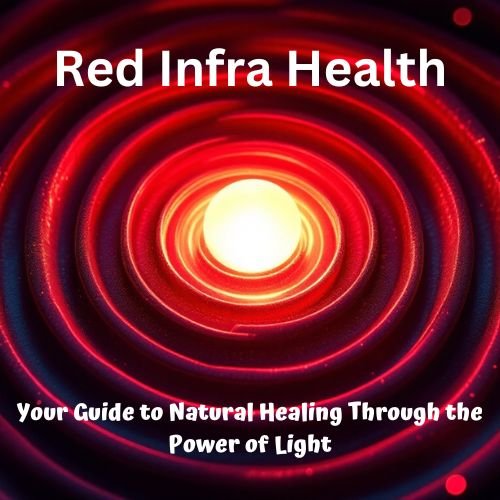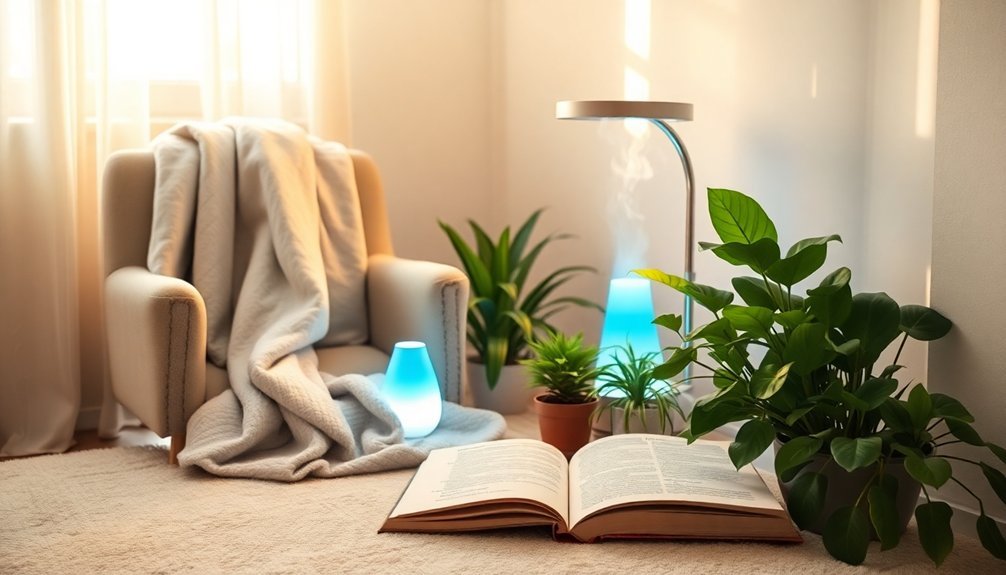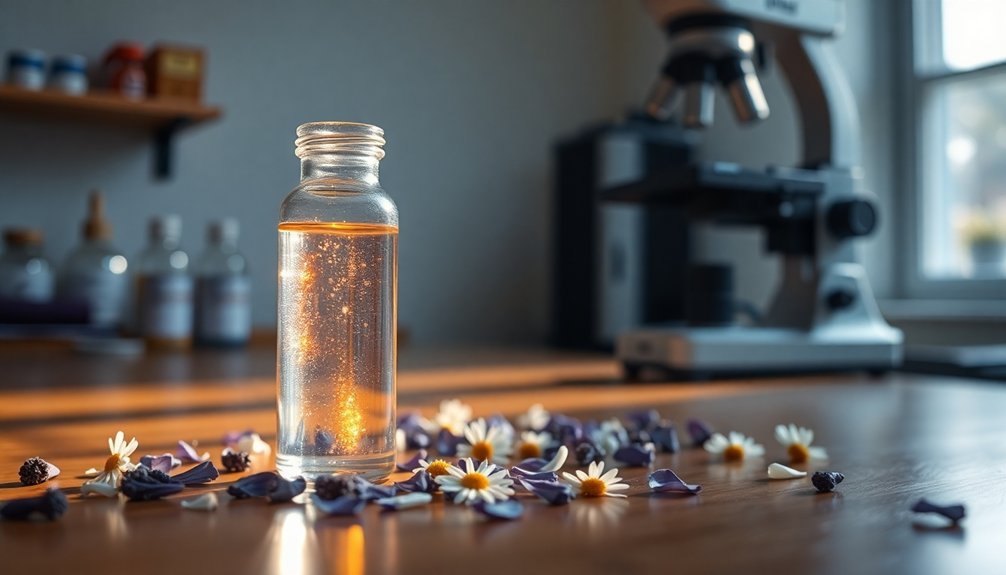Red light therapy naturally boosts your testosterone in seven powerful ways. The light wavelengths directly stimulate your Leydig cells to produce more testosterone while enhancing ATP production in your testes. You'll experience improved sleep quality, which helps maintain peak hormone levels, and better blood circulation for vital nutrient delivery. The therapy reduces stress hormones like cortisol that can interfere with testosterone production. It also accelerates muscle recovery and protects your natural hormone balance. When combined with proper nutrition and exercise, you'll activate even more hormone-enhancing benefits that can transform your vitality and performance.
Red Light and Hormone Production

In light of recent scientific discoveries, red light therapy has emerged as a promising natural method for boosting testosterone levels. When you expose your body to specific wavelengths between 660-850 nm, you're activating a powerful biological response that enhances testosterone production at the cellular level.
The key to this process lies in the stimulation of Leydig cells, which are your body's primary testosterone factories. These cells respond to red and near-infrared light by increasing their ATP production and mitochondrial activity, leading to enhanced hormone synthesis. Declining testosterone levels affect approximately 40% of men who seek help from their primary care providers.
You'll want to maintain consistent exposure through 10-20 minute sessions, 3-4 times weekly, to optimize your results.
What makes this approach particularly appealing is its interaction with your pineal gland, which plays a vital role in reproduction and overall well-being. Unlike traditional hormone therapies, you're supporting your body's natural testosterone production mechanisms without synthetic interventions.
The process is safe, with clinical studies confirming no DNA damage to male reproductive organs. You can even combine this therapy with testosterone-boosting supplements to potentially enhance your results, making it a versatile addition to your hormone optimization strategy.
Cellular Energy for Testosterone Release
Building on the cellular benefits of red light therapy, understanding how your body generates and uses energy for testosterone production opens up new possibilities for hormone optimization.
Your cells require specific nutrients and ideal conditions to maintain healthy testosterone levels, with vitamin B12 playing a vital role in cellular energy metabolism and DNA synthesis.
Your body's hormonal regulation system depends heavily on cellular energy for proper function. When you're dealing with issues like insulin resistance or elevated leptin levels due to excess body fat, your Leydig cells can't efficiently produce testosterone. A decrease in testosterone levels often creates a vicious metabolic cycle that further promotes fat accumulation and insulin resistance.
The presence of inflammatory adipocytokines like TNFα and IL6 further compromises hormone production by inhibiting GNRH and LH release.
You can support your cellular energy production by ensuring adequate intake of key nutrients. Zinc and selenium are essential minerals that directly contribute to testosterone synthesis, while quercetin may help by reducing aromatase activity.
It's essential to note that your cellular energy metabolism isn't just about nutrients – it's also affected by hormones like DHEA, which can become depleted during periods of stress, potentially impacting your testosterone production capacity.
Sleep Quality Enhancement

Sleep profoundly influences your testosterone production, with research showing that just one week of poor sleep can slash your levels by up to 15% – equivalent to aging a decade or more.
Your body produces peak testosterone during REM sleep, maintaining these elevated levels until you wake up. Research shows that afternoon testosterone dips are most pronounced between 2 PM and 10 PM in sleep-deprived individuals.
To optimize your testosterone production through sleep, you'll need to aim for 7-8 hours of quality rest each night. Don't oversleep, though – more than 9.9 hours can actually lower your testosterone levels.
You'll want to focus on establishing consistent sleep patterns and improving your sleep hygiene to support healthy hormone production.
If you're experiencing poor sleep quality, you're likely disrupting your body's natural testosterone production cycle. High cortisol levels from stress can interfere with your sleep quality and testosterone production, creating a negative feedback loop.
You can break this cycle by managing your stress levels, maintaining a healthy weight, and exercising regularly. If you're still struggling with sleep or testosterone concerns, don't hesitate to consult a healthcare professional – they can help identify any underlying sleep disorders or hormone imbalances affecting your health.
Blood Flow Optimization
Red light therapy can improve your blood flow, as its wavelengths penetrate your skin and promote vessel dilation for enhanced circulation.
You'll experience better oxygen and nutrient delivery to your cells when blood vessels are perfectly dilated, which directly supports testosterone production and overall hormonal health.
This improved circulation from red light exposure works alongside your body's natural vasodilation processes to maintain healthy testosterone levels and support endocrine function. The vasodilatory effects help improve coronary artery diameter and optimize blood flow throughout the body's vascular system.
Circulation During Red Light
Ideal blood flow serves as a cornerstone for maintaining healthy testosterone levels, and light therapy's impact on circulation offers a promising natural solution.
When you expose your body to red light at 670 nm wavelength, it stimulates nitric oxide production, triggering vasodilation and enhancing blood flow throughout your system.
You'll experience best results with 5-15 minute sessions at an intensity of 50 mW/cm², allowing the light to penetrate deep into your tissues. This targeted approach improves microcirculation, ensuring oxygen and nutrients reach your cells more effectively while removing waste products and inflammatory mediators.
The benefits extend beyond basic circulation enhancement. You're supporting multiple body systems simultaneously – from reducing inflammation and swelling to accelerating muscle recovery.
If you're dealing with specific conditions like peripheral artery disease or chronic venous insufficiency, you'll find that consistent red light exposure can markedly improve your symptoms.
For maximum effectiveness, you can combine red light therapy with other healthy practices like exercise and proper nutrition. The key lies in maintaining regular sessions, as repeated treatments lead to sustained improvements in blood flow and, consequently, better hormone optimization.
Increased Vessel Dilation Benefits
Three key mechanisms drive the remarkable benefits of increased vessel dilation in your body's circulatory system.
First, when your blood vessels widen, they substantially decrease vascular resistance, allowing blood to flow more freely throughout your body. This enhanced circulation delivers more oxygen and nutrients to your tissues, directly supporting hormone production, including testosterone.
Second, vessel dilation optimizes your body's natural drug delivery system. When your blood vessels expand, they're better equipped to transport hormones, proteins, and other essential compounds to their target tissues. This improved bioavailability means you'll get more benefit from both natural and therapeutic substances in your system.
Your body's response to vasodilation is particularly powerful during physical activity and recovery. As your smooth muscle cells relax and vessels expand, you'll experience better muscle perfusion and enhanced nutrient delivery.
You can maximize these benefits through proper hydration, regular exercise, and stress management techniques. Additionally, certain natural compounds like L-arginine can stimulate nitric oxide production, further enhancing your vasodilation response.
This natural process is completely reversible and won't cause any damage to your blood vessels, making it a safe way to optimize your circulation.
Stress Hormone Reduction

Light exposure plays a vital role in managing your cortisol levels, as morning sunlight can help regulate your body's natural stress response.
You'll notice significant stress relief when you time your light exposure strategically, letting your body release accumulated tension through natural circadian rhythms.
Red light therapy can further support your adrenal health by reducing cortisol production and promoting hormonal balance, which helps optimize your testosterone levels.
Cortisol Defense With Light
Red light therapy offers a powerful defense against cortisol, your body's primary stress hormone. When you expose your body to red light, it triggers a natural reduction in cortisol levels while stimulating your mitochondria, helping your cells recover from stress more efficiently.
This dual action helps create an ideal environment for testosterone production, as high cortisol levels can interfere with testosterone synthesis.
You'll find that red light therapy works through multiple pathways to combat stress hormones. It increases nitric oxide production, which relaxes your blood vessels and lowers blood pressure, while simultaneously boosting serotonin and melatonin levels to improve your mood and sleep quality.
The therapy also supports your endocrine system by enhancing the function of your adrenal glands and thyroid, leading to better overall hormone balance.
The cellular absorption of red light wavelengths increases ATP production and reduces inflammation, creating a foundation for healthy hormone regulation. By targeting your endocrine system directly, red light therapy helps maintain a perfect balance between cortisol and testosterone, ensuring that stress doesn't compromise your body's ability to produce and maintain healthy testosterone levels.
Light-Triggered Stress Release
Stress management takes on a new dimension when you understand how light exposure influences your body's hormone production. When you're exposed to specific light frequencies, your body initiates a natural stress-reduction response that helps regulate cortisol levels and supports healthy testosterone production.
Your body's stress response system operates through complex neural pathways, starting in the amygdala and moving through the hypothalamus. When you're chronically stressed, elevated cortisol levels can suppress your testosterone production.
However, strategic light exposure can help break this cycle by triggering your body's relaxation response.
You'll find that light therapy works with your circadian rhythm to regulate stress hormones. When you combine light exposure with other stress-reduction techniques like deep breathing or meditation, you're creating a powerful defense against cortisol's testosterone-suppressing effects. This dual approach helps restore hormonal balance more effectively than either method alone.
While research is still evolving, you can maximize these benefits by establishing a consistent light exposure routine. Your body responds best to regular patterns, so maintaining scheduled light therapy sessions alongside traditional stress-management techniques will help optimize your hormone levels naturally.
Adrenal Harmony Through Red
When your adrenal glands are functioning ideally, they help maintain the delicate balance between stress hormones and testosterone production. Red light therapy directly supports this balance by reducing cortisol levels, your body's primary stress hormone, which can block testosterone when elevated.
By targeting your adrenal glands, red light therapy enhances mitochondrial health and ATP production, essential components for proper gland function. You'll notice improved stress management as RLT alleviates cortisol dysregulation and promotes a more balanced stress response throughout your body.
The therapy's impact on hormonal balance is particularly significant for testosterone levels. As your cortisol levels decrease through regular RLT sessions, you're creating a favorable environment for testosterone production.
The treatment also reduces inflammation and improves sleep quality, both vital factors in maintaining healthy hormone levels.
If you're struggling with symptoms of high cortisol, such as fatigue, sleep disturbances, or weight gain, RLT can help mitigate these issues. By addressing chronic stress and preventing adrenal fatigue, you're not just managing symptoms – you're supporting your body's natural ability to produce and respond to testosterone effectively.
Muscle Recovery Benefits
Testosterone's powerful influence on muscle recovery transforms your post-workout healing process in multiple ways. When your body maintains ideal testosterone levels, you'll experience enhanced protein synthesis, leading to faster muscle repair and growth.
This hormonal boost also reduces inflammation and muscle damage, allowing you to bounce back more quickly between training sessions.
Your body's ability to uptake nutrients markedly improves with healthy testosterone levels, delivering essential building blocks directly to your muscles. You'll notice increased IGF-1 production, which works alongside testosterone to accelerate muscle repair and promote new tissue growth.
Additionally, you'll preserve more muscle mass as testosterone helps prevent protein breakdown during recovery periods.
These benefits translate into practical training advantages. You'll be able to train more frequently and intensely while reducing your risk of injury.
Your enhanced red blood cell production will improve oxygen delivery to muscles, boosting your endurance during workouts. The combination of faster recovery times and improved muscle protein balance means you'll build strength more efficiently, helping you achieve your fitness goals more quickly while maintaining ideal muscle health.
Natural Testosterone Protection Methods

Building upon your improved recovery capabilities, protecting your testosterone levels naturally requires a thorough approach to lifestyle choices. You'll need to focus on multiple lifestyle factors that work together to maintain vital hormone production.
Start by evaluating your diet, ensuring you're consuming enough healthy fats from sources like avocados, nuts, and olive oil. Include lean proteins and minimize refined carbs and sugar intake.
Your exercise routine should incorporate resistance training, particularly compound movements like squats and bench presses, along with HIIT workouts for maximum hormonal response.
Quality sleep becomes essential in this equation, as poor rest directly impairs testosterone production. You'll want to establish consistent sleep patterns and implement stress management techniques to keep cortisol levels in check. Consider meditation, deep breathing, or other relaxation methods that work for you.
Additionally, you should eliminate harmful habits that compromise testosterone levels. If you smoke, quit. If you drink alcohol frequently, reduce your consumption. Work on maintaining a healthy body weight, as excess abdominal fat profoundly impacts testosterone production.
Finally, minimize your exposure to environmental toxins by choosing natural products when possible.
Frequently Asked Questions
How Long Should Each Red Light Therapy Session Last for Optimal Testosterone Benefits?
You'll want to spend 10-20 minutes per session, 3-4 times weekly, for ideal testosterone benefits. If you're using a high-powered device, you can achieve results in as little as 5 minutes.
Can Red Light Therapy Be Combined With Other Testosterone-Boosting Supplements Safely?
You can safely combine red light therapy with testosterone-boosting supplements, but you'll want to consult your healthcare provider first. The treatments generally work well together and may provide enhanced benefits for hormone production.
At What Distance Should the Red Light Device Be From the Body?
You'll want to position your red light device 6-12 inches from your body for ideal results. This distance prevents overheating while ensuring effective light absorption. Adjust based on your device's intensity and skin sensitivity.
Are There Specific Body Areas That Respond Better to Red Light Therapy?
Yes, your testicles, brain (hypothalamus and pituitary), and adrenal glands respond especially well to red light therapy. Areas with more photoreceptive proteins and blood vessels also show enhanced benefits from treatment.
How Soon After Starting Red Therapy Can Testosterone Improvements Be Measured?
You'll begin seeing measurable testosterone improvements after several weeks of consistent red light therapy, with significant changes taking up to 3-4 months. You can notice initial benefits like improved mood within 3-4 weeks.
In Summary
You'll find red light therapy offers a natural, science-backed approach to optimizing your testosterone levels. By implementing these seven methods, you're supporting your body's hormone production, enhancing sleep quality, and improving cellular function. Whether you're looking to boost athletic performance or maintain hormonal health, red light therapy can become a valuable addition to your wellness routine. Start small and stay consistent with your treatments.





Leave a Reply